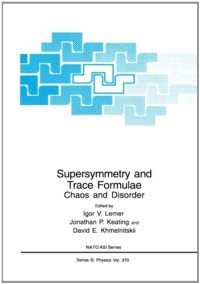
Ebook: Supersymmetry and trace formulae: chaos and disorder
- Tags: Theoretical Mathematical and Computational Physics, Statistical Physics Dynamical Systems and Complexity, Quantum Physics, Condensed Matter Physics
- Series: NATO ASI Series 370 Series B
- Year: 1999
- Publisher: Springer US
- Edition: 1
- Language: English
- djvu
The motion of a particle in a random potential in two or more dimensions is chaotic, and the trajectories in deterministically chaotic systems are effectively random. It is therefore no surprise that there are links between the quantum properties of disordered systems and those of simple chaotic systems. The question is, how deep do the connec tions go? And to what extent do the mathematical techniques designed to understand one problem lead to new insights into the other? The canonical problem in the theory of disordered mesoscopic systems is that of a particle moving in a random array of scatterers. The aim is to calculate the statistical properties of, for example, the quantum energy levels, wavefunctions, and conductance fluctuations by averaging over different arrays; that is, by averaging over an ensemble of different realizations of the random potential. In some regimes, corresponding to energy scales that are large compared to the mean level spacing, this can be done using diagrammatic perturbation theory. In others, where the discreteness of the quantum spectrum becomes important, such an approach fails. A more powerful method, devel oped by Efetov, involves representing correlation functions in terms of a supersymmetric nonlinear sigma-model. This applies over a wider range of energy scales, covering both the perturbative and non-perturbative regimes. It was proved using this method that energy level correlations in disordered systems coincide with those of random matrix theory when the dimensionless conductance tends to infinity.
This volume provides a representative overview of recent progress in the theories of quantum disordered and chaotic systems, and an introduction to the underlying concepts and techniques